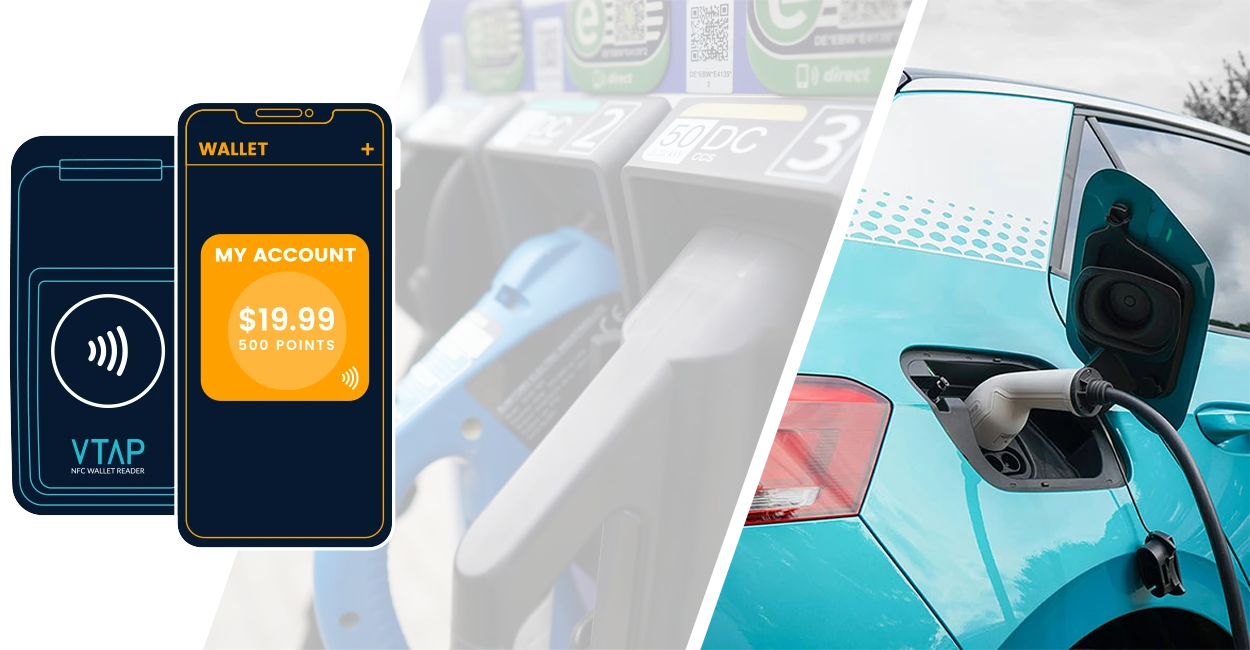Accept NFC Wallet payments for EV charging and vending
EV charging and vending operators are adding NFC Wallet readers to their infrastructure for frictionless closed loop payments.

Accept NFC Wallet payments for EV charging and vending

Digital stored value cards are a low cost option for EV charging or cashless vending when open loop (EMV) card payments are not required. Users register for an account, add the NFC digital card to their wallet and load their wallet pass with credit. Charging their car is then just a simple ‘tap’ of a phone on the reader, and the remaining balance can be updated and topped up at any time. VTAP NFC readers are less expensive than card payment terminals and are already certified for Apple Wallet and Google Wallet stored value payment acceptance.
Why is NFC Wallet great for EV charging and vending?
Frictionless payment
NFC Wallet payments work just like Apple Pay or Google Pay but using a private membership account card in the wallet instead of a bank card. Payment can be processed online to load value or settle an account balance.
Save money
EV charging or vending payments using closed loop (non-EMV) payment processing can be handled with lower costs than credit or debit cards, as the account is topped up less frequently than spend, reducing loading and settlement fees.
Greater flexibility
NFC Wallet payments do not rely on complex and expensive EMV payment terminals that support all credit, debit, chip and PIN and contactless payment cards, as the stored value account can be topped up online.
VTAP for success
40+
countries
69k+
tap points
20m+
consumers
What else can NFC readers do to improve charging and vending?
Sign-up
Between charging or vending activities, the NFC reader can be switched into ‘enrolment’ mode. When a customer taps on the reader, their smartphone will automatically open a contextually relevant account sign-up link.
Loyalty
NFC Wallet loyalty scheme passes can be automatically used to apply discounts to the current transaction and collect points. Multiple loyalty schemes can be supported by the NFC reader on the machine.
Membership check
NFC Wallet membership passes can be used for free or discounted charging or vending, depending on the membership level of the user. Spend could be allocated against an account for payment at a later date.
Why is VTAP technology perfect for EV charging and vending?
Easy migration to NFC
VTAP readers simplify migration to the ‘just tap’ NFC experience for stored value payments. A universal range of connectivity options ensures NFC Wallet readers can be quickly and easily integrated into any attended or unattended environment.
Strong security
NFC-enabled digital cards are protected by the strong security of Apple Wallet and Google Wallet and are securely read by certified VTAP readers. VTAP reader keys and application data can be securely managed locally, or remotely via VTAP Cloud.
Flexible NFC
VTAP readers can be switched to ‘NFC tag emulation’ mode to trigger a secure in-app payment experience via bank or payment provider apps, replacing QR codes. NFC Wallet taps can also trigger charges to a stored payment card in a customer account.
How does VTAP make NFC Wallet payment migration easier?
Legacy technology support
VTAP readers work with RFID cards, tags, wristbands and fobs, enabling support for, and migration from, existing closed loop payment instruments. Readers can be used to directly replace existing RFID and QR code scanners or work seamlessly alongside them.
NFC pass integration
VTAP readers work with any Apple Wallet and Google Wallet pass issuance platform that supports NFC, using the standard Apple and Google developer APIs. Many wallet pass issuance platforms and stored value providers are already familiar and integrated with VTAP technology.
Apple and Google certified
VTAP readers are fully certified for Apple VAS, Google Smart Tap and Apple ECP2/Access. Security keys and application data are securely managed locally over USB, or via VTAP Cloud, creating end-to-end security and peace of mind.
